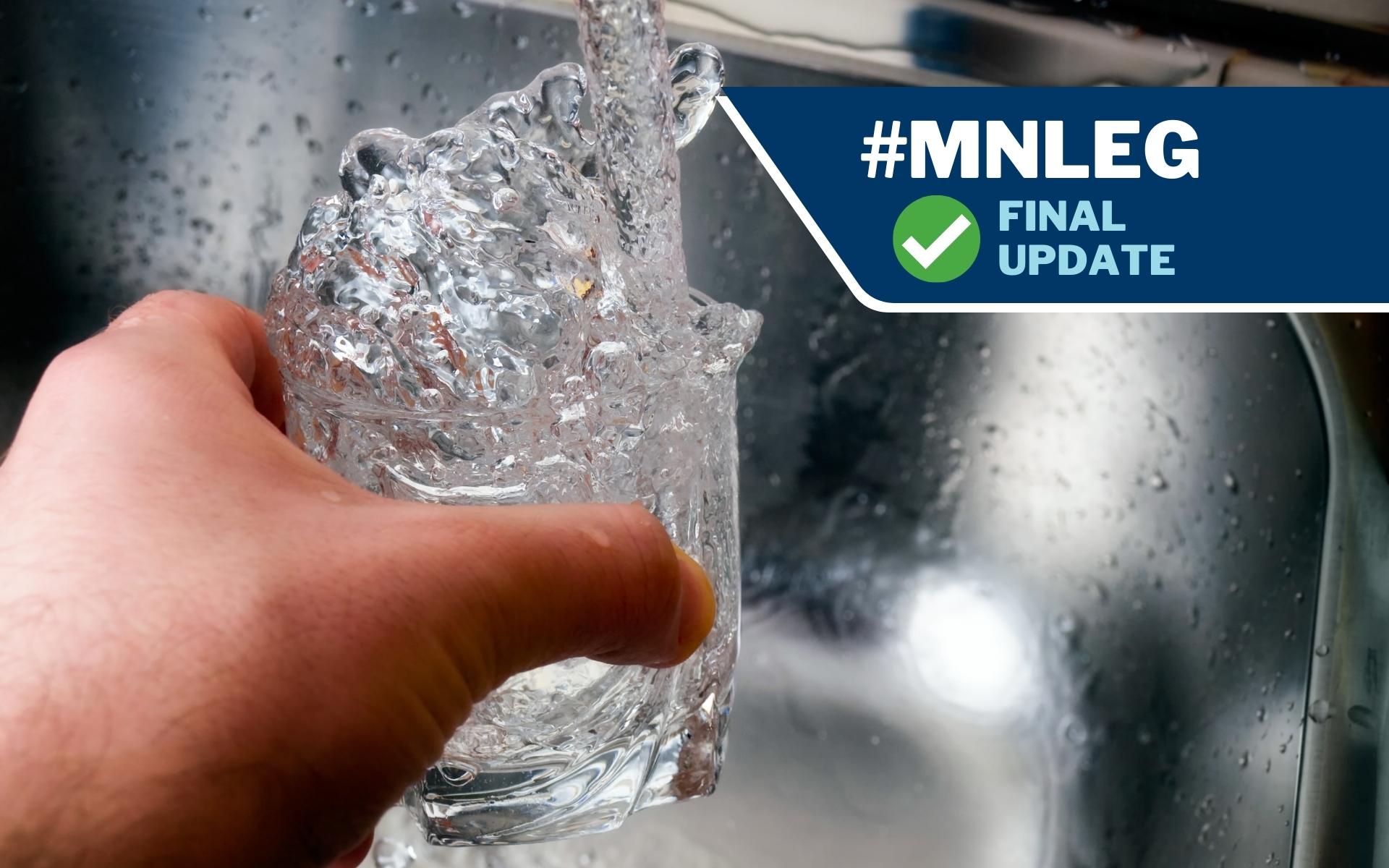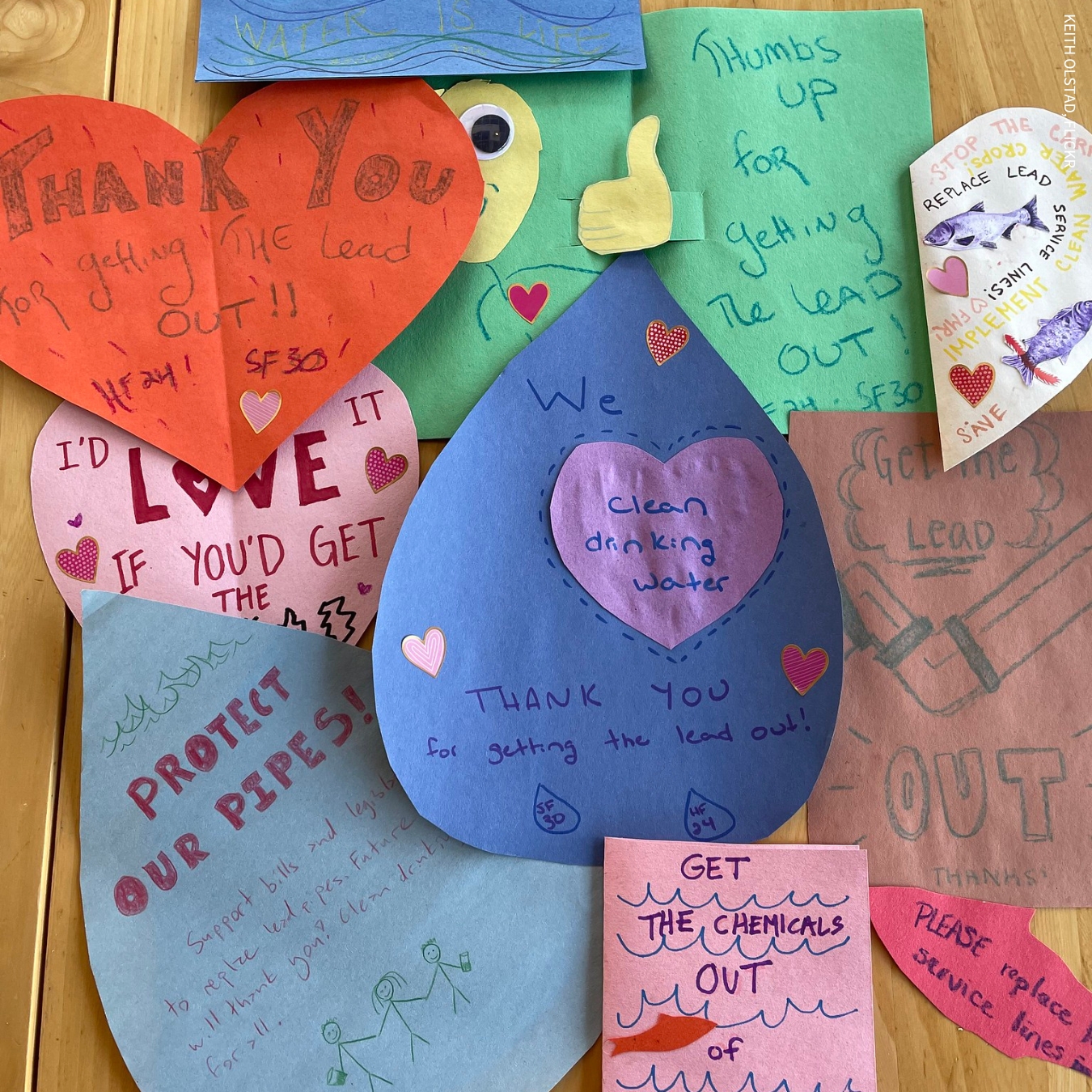Minnesota takes a giant leap toward clean drinking water for all

Lead service lines remain a significant source of exposure to the toxic metal. This bill will get us closer to full replacement. Read how all FMR priorities fared this legislative session.
Minnesota has taken a giant leap toward our goal of replacing all lead drinking water lines in the state within the next decade.
Thanks to the dedicated leadership of Rep. Sydney Jordan (DFL-Minneapolis) and Sen. Jen McEwen (DFL-Duluth), lawmakers voted overwhelmingly in the House (129-0) and Senate (64-2) to provide $240 million for lead service line inventory and replacement. Gov. Tim Walz signed the bill into law at a ceremony this afternoon.
These state funds will also take advantage of $215 million in matching dollars made available to Minnesota through 2021’s federal infrastructure bill, the Infrastructure Investment and Jobs Act.
Combined, this money will allow for the replacement of a significant percentage of the estimated 100,000-plus lead service lines still in use in Minnesota.
FMR seeks to ensure adequate public investment in our state's water infrastructure — especially wastewater and drinking water investments that are critical to public health and environmental justice. By finally addressing these long-overdue upgrades, we can begin replacing these dangerous pipes and free up future resources for other investments in our natural resources.
What exactly is in the bill?
Of the $240 million, about $24 million is set aside to cover the cost of mapping and inventorying lead service lines that need replacement. These funds are vital because, under the federal lead and copper rule, all public water systems must complete a lead service line inventory by October 2024.
What’s left of that $240 million will go to help replace those existing lead service lines.
Replacement funds will be available statewide but are targeted and prioritized based on a series of criteria, including:
- Areas with children with elevated blood lead levels
- Areas with children under the age of 5
- Lower-income residents and other disadvantaged communities
- Coordination of the replacement with other public works projects (as it’s a great way to stretch these dollars even further)
An enormous impact on public health
Lead services lines are the pipes that connect a home or building to the public water main. While we know that pipes and solder installed before 1986 are more likely to have high lead levels, we do not yet know where all of Minnesota’s estimated 100,000-plus existing lead service lines are located — or who owns them. As a result, it’s impossible to say precisely how much it will cost to replace each and every one of them.
The state has estimated the total statewide replacement cost to be at least $800 million. As a result, the newly passed $240 million plus the federal match it secures ($43 million per year over five years) will support roughly half of the long-term funding that is ultimately needed.
‘These funds will protect and enhance public health while providing much-needed peace of mind to residents across the state," said Trevor Russell, FMR's Water Program Director.
In addition, replacement projects are expected to provide a real economic return. As then-Commissioner of Health Jan Malcolm noted in 2019, every $1 spent on addressing lead in drinking water returns at least $2 in benefits to the state.
Thank you, River Guardians

A sampling of the Valentine's Day cards River Guardians and advocates made at an FMR event during the 2023 legislative session. (Photo by FMR)
Thank you to our River Guardians, who contacted lawmakers with emails, phone calls and even Valentine’s Day cards urging support for these funds.
Because of you, Minnesota is one step closer to lead-free drinking water.
Previous 2023 updates
Feb. 15: Lead service line replacement: The latest from the MN Leg
Minnesota lawmakers moved quickly on lead service line legislation this year, introducing bills in the opening days of the session to find and replace 100% of existing lead service lines in the state.
Where does this effort stand now, more than a month in?
There are two bills — one in the House, one in the Senate — that have received bipartisan support from lawmakers in St. Paul.
HF 24 from Rep. Sydney Jordan has 34 listed co-authors, and quickly made its way through the Economic Development Finance and Policy committee. The companion bill in the Senate, SF 30 from Sen. Jen. McEwen, has four listed authors.
Both the House and Senate versions of the legislation establish two grant programs:
- One for mapping all publicly and privately owned lead service lines that exist within the state. (An estimated 100,000 homes in Minnesota still get water via lead service lines.)
- And another for replacing those lines with safer materials within the next decade.
Each bill is currently with a committee: Environment and Natural Resources Finance and Policy in the House, Jobs and Economic Development in the Senate.
Committees in both chambers will hold hearings on their respective bills in the weeks to come, with one or more such stops before they head to a floor vote (where legislators actually vote yea or nay on a bill) or, potentially, get integrated with larger bills.
FMR’s Water Program will be monitoring the progress of the bills all the way through the session. We’ll provide updates on this page as they unfold.
Feb. 2: The latest from the MN Leg
A bill to replace all hazardous lead service lines in the state of Minnesota within the next decade is heading toward its first Senate hurdle.
That chamber’s Jobs and Economic Development committee will hear testimony at a Monday, Feb. 6 meeting, regarding SF30. (Update: This particular hearing has been delayed. We'll provide an updated date as soon as we have it.) The legislation would establish two grant programs: One for mapping all publicly and privately owned lead service lines that exist within the state, and another for replacing those lines. The bill sets a goal of having this work done in the next decade.
There is a companion bill in the House, HF24, that is currently making its way through committees in that chamber. You can read more in our previous updates below.
The Senate bill was introduced by Sen. Jen McEwen of Duluth. Additional authors include Sens. Sandra Pappa, Jim Abeler and Majority Leader Kari Dziedzic.
An estimated at least 100,000 homes in Minnesota still have a lead service line. Those are the pipes that connect a home’s plumbing system to the water main. Lead services lines can taint drinking water and are a significant source of exposure to the toxic metal, which can be particularly hazardous to children.
You can read more about the scope of the issue — and possible solutions — in this FMR update.
Jan. 20: Lead service line bill advances through first House committee
The House Economic Development Finance and Policy Committee passed a lead service line bill by unanimous voice vote, sending the legislation to its next committee stop.
That committee, chaired by Rep. Hodan Hassan, gave the green light to HF 24 during its Jan. 18 meeting. It will now head to the Health Finance and Policy Committee for further consideration.
Today @SydneyJordanMN's HF24 passed @RepHassan's #MNHouse Econ Dev Committee!
— Conservation MN (@ConservationMN) January 18, 2023
HF24 provides vital funding to map and remove all of MN’s lead service lines by 2033. For too long, Minnesotans have been exposed to toxic lead in their drinking water. Let's end this crisis. #mnleg pic.twitter.com/1SywUifoJZ
FMR submitted a letter expressing strong support for HF24, describing the legislation's pairing with federal funding opportunities as " a once-in-a-generation opportunity to protect public health by removing all of Minnesota's lead service lines."
Authored by Rep. Sydney Jordan of Minneapolis, the bill would establish grant programs to both map and replace lead service lines across the state over the next decade. A companion bill in the Minnesota Senate, SF 30, is with that chamber's Jobs and Economic Development Committee.
Read more about why it's time to find and replace lead service lines in Minnesota.
Jan. 17: FMR submits letter in support of House lead service line bill
There is early movement on the lead service line replacement bill in the Minnesota House.
The House Economic Development Finance and Policy Committee will hear HF 24 during its meeting on Wednesday, Jan. 18. It's scheduled to start at 10:30 a.m. You can find more information about the meeting here.
HF 24, authored by Rep. Sydney Jordan of Minneapolis, would establish grant programs to map and replace lead service lines across the state by 2033. The bill has more than two dozen co-authors. FMR wrote and submitted a letter of support to the the chair, Rep. Hodan Hassan of Minneapolis, as well as the other members of the committee.
"As amended, HF24 sets a statewide lead service line replacement goal and provides much-needed funding to make that possible," FMR's letter (see a copy here) reads. "This legislation, paired with unprecedented federal funding support, represents a once-in-a-generation opportunity to protect public health by removing all of Minnesota's lead service lines. We greatly appreciate Rep. Jordan’s strong leadership on this issue and urge you to support HF 24 this session."
Over in the Senate, DFL Sen. Jen McEwen of Duluth has previously introduced SF 30. That bill has been referred to the Senate's Jobs and Economic Development Committee.
Read more about why it's time to find and replace lead service lines in Minnesota.
Jan. 5: Lead service line replacement bills introduced
Just days into the 2023 legislative session, FMR is pleased to note state lawmakers have already introduced legislation to replace lead service lines in Minnesota.
Rep. Sydney Jordan, DFL-Minneapolis, introduced HF 24 in the House on Jan. 4. The bill already has 28 co-authors, including numerous stalwart environmental champions. This bill has been referred to the Economic Development Finance and Policy Committee.
On the Senate side, DFL Sen. Jen McEwen of Duluth introduced SF 30 on the same day. Co-authors are pending in that chamber, and the bill has been referred to the Senate's Jobs and Economic Development Committee.
These bills set a statewide goal of replacing all lead service lines by 2033, and would do so by establishing a pair of grant programs. The first program would provide grants for mapping lead service lines (so we actually know where they are). The second grant program would provide funds for replacement of those lines.
Importantly, the bills include workforce development and prevailing wage elements that help ensure communities most impacted by lead service lines benefit from public funds.
Leaders in both chambers have said addressing lead service lines is one of their priorities for the 2023 legislative session.